2004 CADILLAC SEVILLE seats
[x] Cancel search: seatsPage 1 of 410
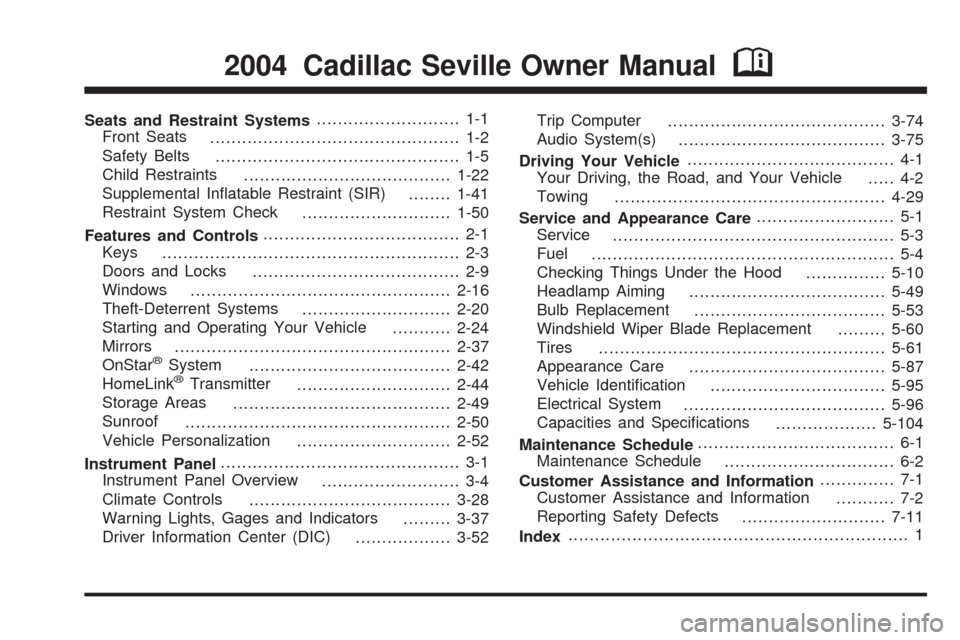
Seats and Restraint Systems........................... 1-1
Front Seats
............................................... 1-2
Safety Belts
.............................................. 1-5
Child Restraints
.......................................1-22
Supplemental Inflatable Restraint (SIR)
........1-41
Restraint System Check
............................1-50
Features and Controls..................................... 2-1
Keys
........................................................ 2-3
Doors and Locks
....................................... 2-9
Windows
.................................................2-16
Theft-Deterrent Systems
............................2-20
Starting and Operating Your Vehicle
...........2-24
Mirrors
....................................................2-37
OnStar
®System
......................................2-42
HomeLink®Transmitter
.............................2-44
Storage Areas
.........................................2-49
Sunroof
..................................................2-50
Vehicle Personalization
.............................2-52
Instrument Panel............................................. 3-1
Instrument Panel Overview
.......................... 3-4
Climate Controls
......................................3-28
Warning Lights, Gages and Indicators
.........3-37
Driver Information Center (DIC)
..................3-52Trip Computer
.........................................3-74
Audio System(s)
.......................................3-75
Driving Your Vehicle....................................... 4-1
Your Driving, the Road, and Your Vehicle
..... 4-2
Towing
...................................................4-29
Service and Appearance Care.......................... 5-1
Service
..................................................... 5-3
Fuel
......................................................... 5-4
Checking Things Under the Hood
...............5-10
Headlamp Aiming
.....................................5-49
Bulb Replacement
....................................5-53
Windshield Wiper Blade Replacement
.........5-60
Tires
......................................................5-61
Appearance Care
.....................................5-87
Vehicle Identification
.................................5-95
Electrical System
......................................5-96
Capacities and Specifications
...................5-104
Maintenance Schedule..................................... 6-1
Maintenance Schedule
................................ 6-2
Customer Assistance and Information.............. 7-1
Customer Assistance and Information
........... 7-2
Reporting Safety Defects
...........................7-11
Index................................................................ 1
2004 Cadillac Seville Owner ManualM
Page 4 of 410
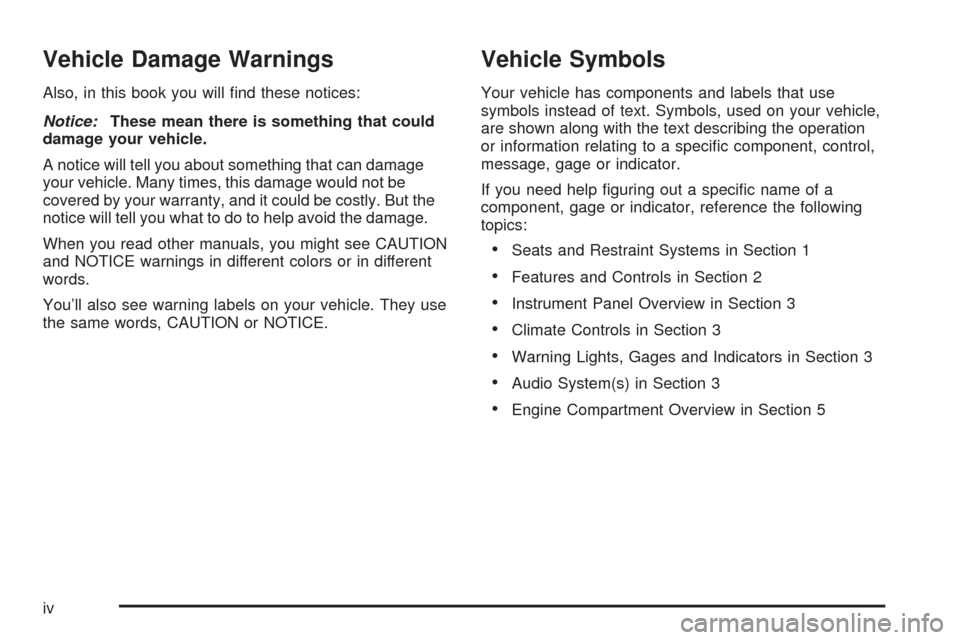
Vehicle Damage Warnings
Also, in this book you will find these notices:
Notice:These mean there is something that could
damage your vehicle.
A notice will tell you about something that can damage
your vehicle. Many times, this damage would not be
covered by your warranty, and it could be costly. But the
notice will tell you what to do to help avoid the damage.
When you read other manuals, you might see CAUTION
and NOTICE warnings in different colors or in different
words.
You’ll also see warning labels on your vehicle. They use
the same words, CAUTION or NOTICE.
Vehicle Symbols
Your vehicle has components and labels that use
symbols instead of text. Symbols, used on your vehicle,
are shown along with the text describing the operation
or information relating to a specific component, control,
message, gage or indicator.
If you need help figuring out a specific name of a
component, gage or indicator, reference the following
topics:
•Seats and Restraint Systems in Section 1
•Features and Controls in Section 2
•Instrument Panel Overview in Section 3
•Climate Controls in Section 3
•Warning Lights, Gages and Indicators in Section 3
•Audio System(s) in Section 3
•Engine Compartment Overview in Section 5
iv
Page 7 of 410
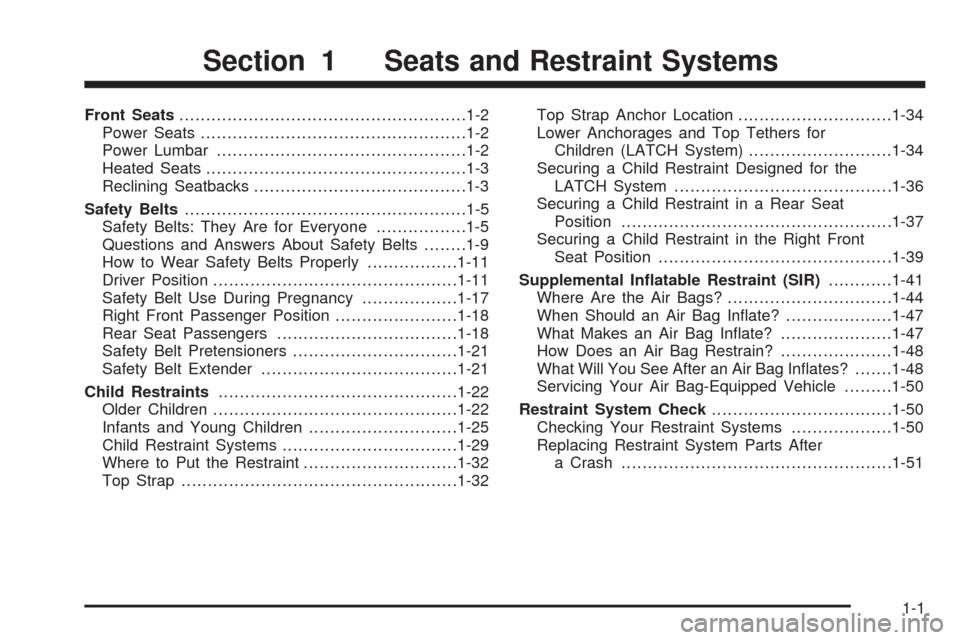
Front Seats......................................................1-2
Power Seats..................................................1-2
Power Lumbar...............................................1-2
Heated Seats.................................................1-3
Reclining Seatbacks........................................1-3
Safety Belts.....................................................1-5
Safety Belts: They Are for Everyone.................1-5
Questions and Answers About Safety Belts........1-9
How to Wear Safety Belts Properly.................1-11
Driver Position..............................................1-11
Safety Belt Use During Pregnancy..................1-17
Right Front Passenger Position.......................1-18
Rear Seat Passengers..................................1-18
Safety Belt Pretensioners...............................1-21
Safety Belt Extender.....................................1-21
Child Restraints.............................................1-22
Older Children..............................................1-22
Infants and Young Children............................1-25
Child Restraint Systems.................................1-29
Where to Put the Restraint.............................1-32
Top Strap....................................................1-32Top Strap Anchor Location.............................1-34
Lower Anchorages and Top Tethers for
Children (LATCH System)...........................1-34
Securing a Child Restraint Designed for the
LATCH System.........................................1-36
Securing a Child Restraint in a Rear Seat
Position...................................................1-37
Securing a Child Restraint in the Right Front
Seat Position............................................1-39
Supplemental Inflatable Restraint (SIR)............1-41
Where Are the Air Bags?...............................1-44
When Should an Air Bag Inflate?....................1-47
What Makes an Air Bag Inflate?.....................1-47
How Does an Air Bag Restrain?.....................1-48
What Will You See After an Air Bag Inflates?.......1-48
Servicing Your Air Bag-Equipped Vehicle.........1-50
Restraint System Check..................................1-50
Checking Your Restraint Systems...................1-50
Replacing Restraint System Parts After
a Crash...................................................1-51
Section 1 Seats and Restraint Systems
1-1
Page 8 of 410
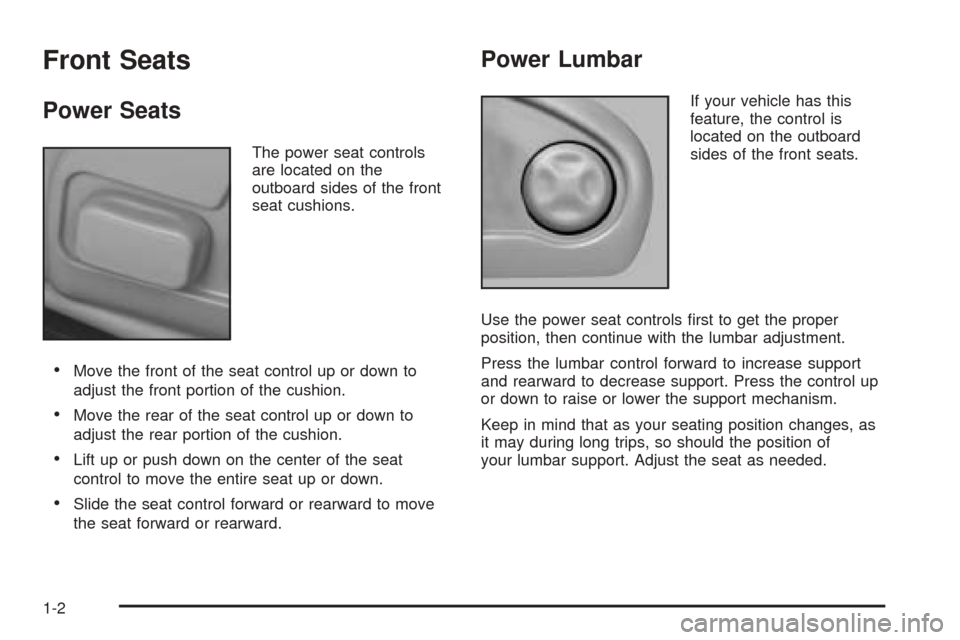
Front Seats
Power Seats
The power seat controls
are located on the
outboard sides of the front
seat cushions.
•Move the front of the seat control up or down to
adjust the front portion of the cushion.
•Move the rear of the seat control up or down to
adjust the rear portion of the cushion.
•Lift up or push down on the center of the seat
control to move the entire seat up or down.
•Slide the seat control forward or rearward to move
the seat forward or rearward.
Power Lumbar
If your vehicle has this
feature, the control is
located on the outboard
sides of the front seats.
Use the power seat controls first to get the proper
position, then continue with the lumbar adjustment.
Press the lumbar control forward to increase support
and rearward to decrease support. Press the control up
or down to raise or lower the support mechanism.
Keep in mind that as your seating position changes, as
it may during long trips, so should the position of
your lumbar support. Adjust the seat as needed.
1-2
Page 9 of 410
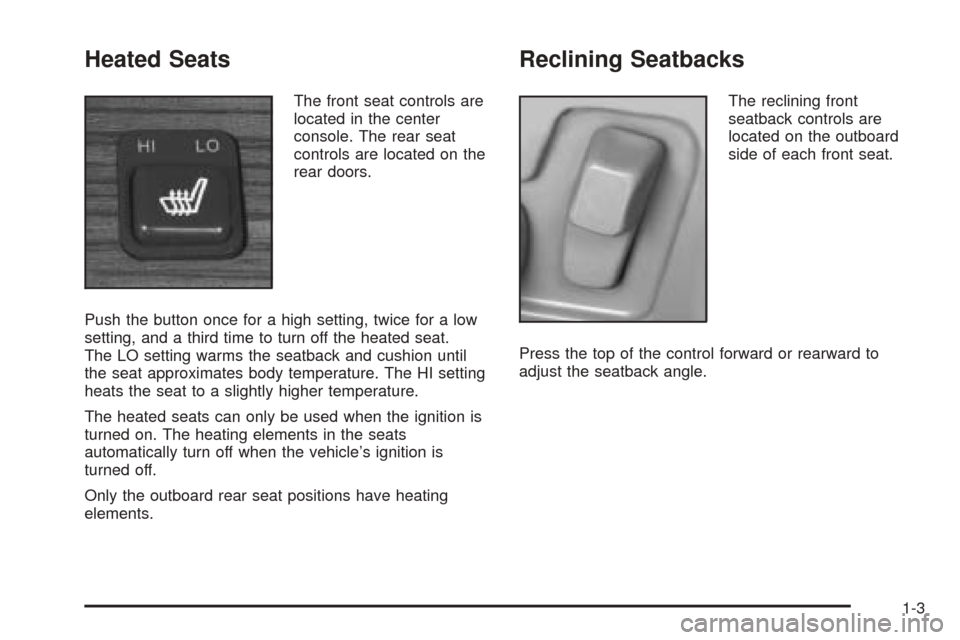
Heated Seats
The front seat controls are
located in the center
console. The rear seat
controls are located on the
rear doors.
Push the button once for a high setting, twice for a low
setting, and a third time to turn off the heated seat.
The LO setting warms the seatback and cushion until
the seat approximates body temperature. The HI setting
heats the seat to a slightly higher temperature.
The heated seats can only be used when the ignition is
turned on. The heating elements in the seats
automatically turn off when the vehicle’s ignition is
turned off.
Only the outboard rear seat positions have heating
elements.
Reclining Seatbacks
The reclining front
seatback controls are
located on the outboard
side of each front seat.
Press the top of the control forward or rearward to
adjust the seatback angle.
1-3
Page 11 of 410
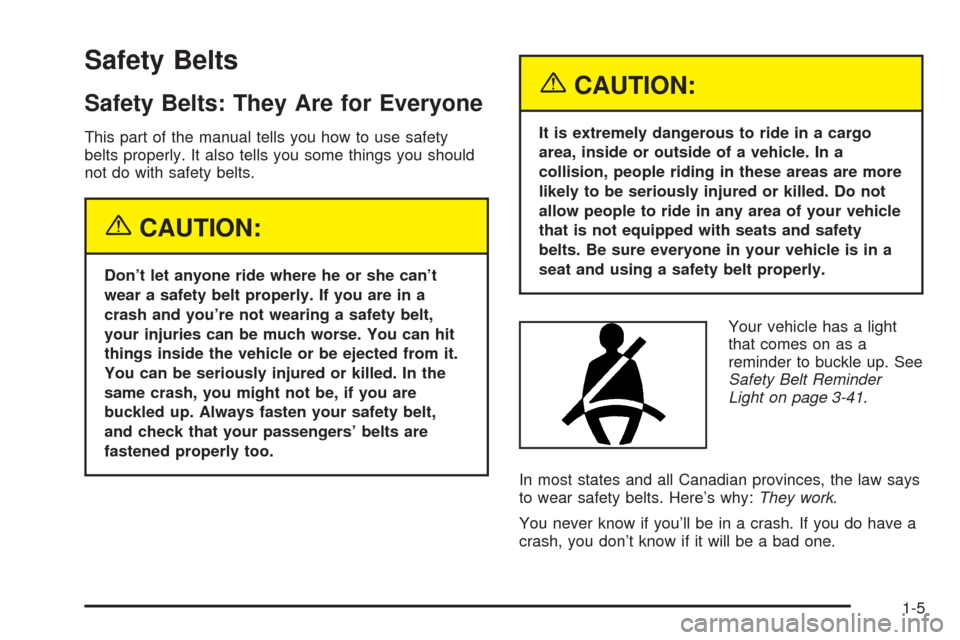
Safety Belts
Safety Belts: They Are for Everyone
This part of the manual tells you how to use safety
belts properly. It also tells you some things you should
not do with safety belts.
{CAUTION:
Don’t let anyone ride where he or she can’t
wear a safety belt properly. If you are in a
crash and you’re not wearing a safety belt,
your injuries can be much worse. You can hit
things inside the vehicle or be ejected from it.
You can be seriously injured or killed. In the
same crash, you might not be, if you are
buckled up. Always fasten your safety belt,
and check that your passengers’ belts are
fastened properly too.
{CAUTION:
It is extremely dangerous to ride in a cargo
area, inside or outside of a vehicle. In a
collision, people riding in these areas are more
likely to be seriously injured or killed. Do not
allow people to ride in any area of your vehicle
that is not equipped with seats and safety
belts. Be sure everyone in your vehicle is in a
seat and using a safety belt properly.
Your vehicle has a light
that comes on as a
reminder to buckle up. See
Safety Belt Reminder
Light on page 3-41.
In most states and all Canadian provinces, the law says
to wear safety belts. Here’s why:They work.
You never know if you’ll be in a crash. If you do have a
crash, you don’t know if it will be a bad one.
1-5
Page 17 of 410
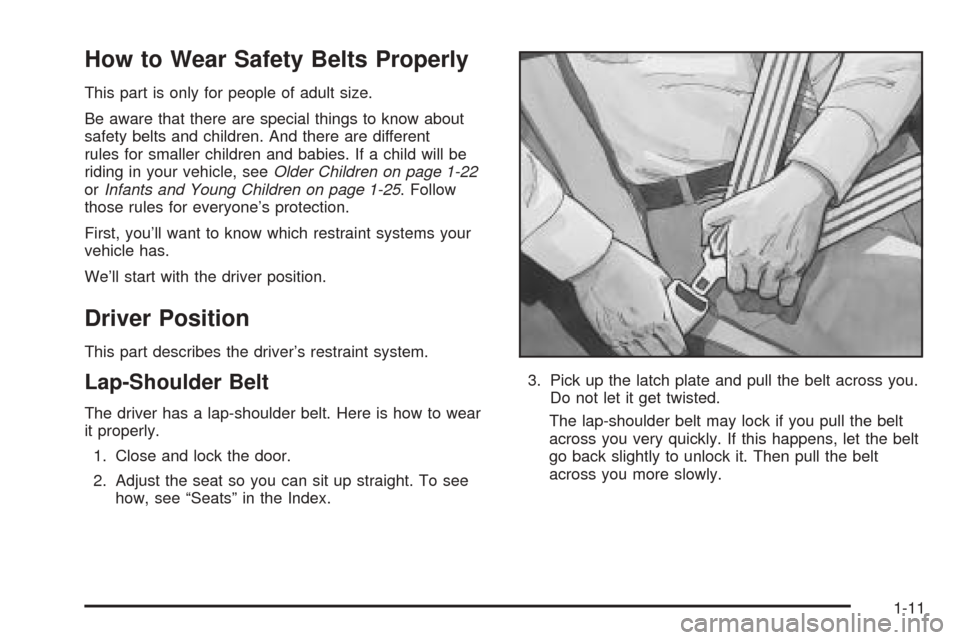
How to Wear Safety Belts Properly
This part is only for people of adult size.
Be aware that there are special things to know about
safety belts and children. And there are different
rules for smaller children and babies. If a child will be
riding in your vehicle, seeOlder Children on page 1-22
orInfants and Young Children on page 1-25. Follow
those rules for everyone’s protection.
First, you’ll want to know which restraint systems your
vehicle has.
We’ll start with the driver position.
Driver Position
This part describes the driver’s restraint system.
Lap-Shoulder Belt
The driver has a lap-shoulder belt. Here is how to wear
it properly.
1. Close and lock the door.
2. Adjust the seat so you can sit up straight. To see
how, see “Seats” in the Index.3. Pick up the latch plate and pull the belt across you.
Do not let it get twisted.
The lap-shoulder belt may lock if you pull the belt
across you very quickly. If this happens, let the belt
go back slightly to unlock it. Then pull the belt
across you more slowly.
1-11
Page 28 of 410
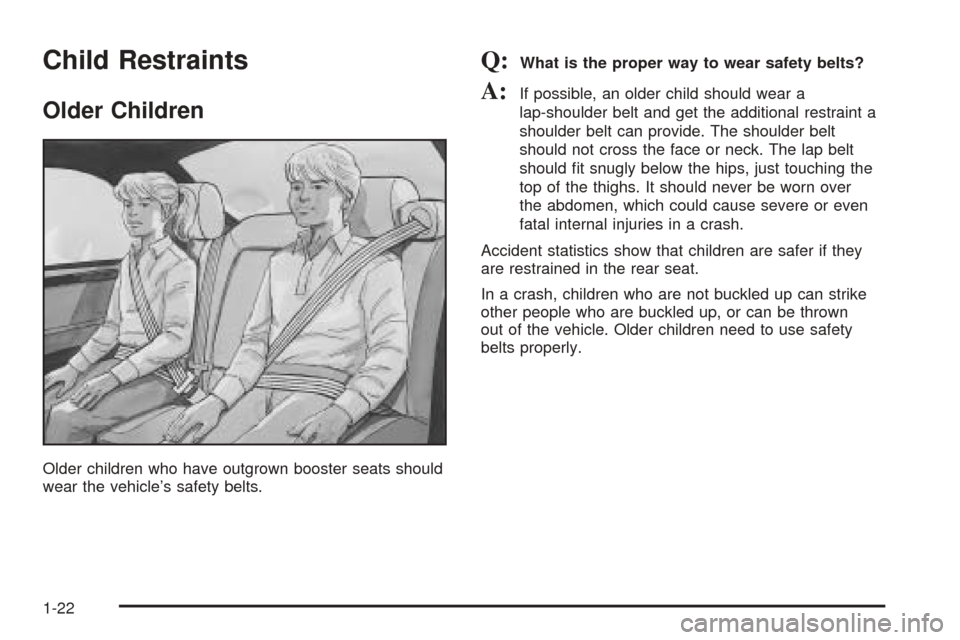
Child Restraints
Older Children
Older children who have outgrown booster seats should
wear the vehicle’s safety belts.
Q:What is the proper way to wear safety belts?
A:If possible, an older child should wear a
lap-shoulder belt and get the additional restraint a
shoulder belt can provide. The shoulder belt
should not cross the face or neck. The lap belt
should fit snugly below the hips, just touching the
top of the thighs. It should never be worn over
the abdomen, which could cause severe or even
fatal internal injuries in a crash.
Accident statistics show that children are safer if they
are restrained in the rear seat.
In a crash, children who are not buckled up can strike
other people who are buckled up, or can be thrown
out of the vehicle. Older children need to use safety
belts properly.
1-22